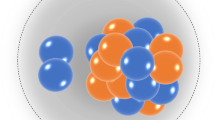Abstract
StrongB(E1) transitions have been recently observed between states in the18O nucleus which follow roughly the energy sequence of a dimolecular α+14C rotator. These findings have been interpreted by Gai et al. as evidence for a molecular dipole degree of freedom being present in the18O nucleus. However, this idea was contradicted by the results of a microscopic multichannel calculation performed by Descouvemont and Baye which was based on elastic α+14C and inelastic α+14C(2+) many-body cluster wave functions. We have improved this study by performing a microscopic multichannel calculation including additionally an+17O many-body fragmentation in order to enlarge our model space by those shell model components which dominate the structure of the (positive parity)18O ground state band. Like Descouvemont and Baye we find a positive parity α+14C molecular band in18O and, additionally, a rather strong collectivity in the lowest 1−, 3− and 5− states in18O. However, since the internal structure is different within these states, the calculated states should not be interpreted as a negative parity α+14C molecular band. In this perspective, the microscopic multichannel calculations do not support the hypothesis of a molecular dipole degree of freedom being present in the18O nucleus.
Similar content being viewed by others
References
Iachello, F.: Phys. Rev.C23, 2778 (1981)
Iachello, F., Jackson, A.D.: Phys. Lett.108B, 151 (1982)
Gai, M., Ruscev, M., Ennis, J.F., Keddy, R., Schloemer, E.C., Sterbenz, S.M., Bromley, D.A.: Phys. Rev. Lett.50, 239 (1983)
Alhassid, Y., Gai, M., Bertsch, G.F.: Phys. Rev. Lett.49, 1482 (1982)
Langanke, K., Stademann, R., Frekers, D.: Phys. Rev. C29, 40 (1984)
Assenbaum, H.J., Langanke, K., Weiguny, A.: Z. Phys. A — Atoms and Nuclei318, 35 (1984)
Descouvemont, P., Baye, D.: Phys. Lett.127B, 286 (1983)
Descouvemont, P., Baye, D.: Phys. Rev. C31, 2274 (1985)
Suzuki, Y., Yamamoto, A., Ikeda, K.: Nucl. Phys. A444, 365 (1985)
Kamimura, M.: Progr. Theor. Phys. Suppl.62, 236 (1977)
Funck, C., Langanke, K.: Nucl. Phys. A464, 90 (1987)
Volkov, A.B.: Nucl. Phys.74, 33 (1965)
Ajzenberg-Selove, F.: Nucl. Phys. A375, 1 (1982)
Wintgen, D., Friedrich, H., Langanke, K.: Nucl. Phys. A408, 239 (1983)
Lawson, R.D., Serduke, F.J.D., Fortune, H.T.: Phys. Rev. C14, 1245 (1976)
Gai, M., Keddes, R., Bromley, D.A., Olness, J.W., Warburton, E.K.: Phys. Rev. C36, 1256 (1987)
Gai, M., Rugari, L., France, R.H., Lund, B.J., Zhao, Z., Bromley, D.A., Lincoln, B.A., Smith, W.W., Zarcone, M.J., Kessel, Q.C.: Phys. Rev. Lett.62, 874 (1989)
Ajzenberg-Selove, F.: Nucl. Phys. A475, 1 (1987)
Author information
Authors and Affiliations
Rights and permissions
About this article
Cite this article
Funck, C., Grund, B. & Langanke, K. Microscopic multichannel calculation of the molecular dipole degree of freedom in the18O nucleus. Z. Physik A - Atomic Nuclei 334, 1–9 (1989). https://doi.org/10.1007/BF01294382
Received:
Issue Date:
DOI: https://doi.org/10.1007/BF01294382




